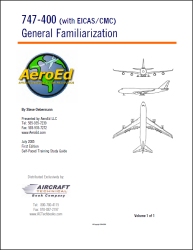

13) When it is possible, complete the taxi in a straight-line roll for a minimum of 10 feet. When you use the brakes during a turn, they will cause the main and nose landing gear tires to wear. 12) Do not use the brakes to help during a turn.

11) Do not let the airplane stop during a turn. 10) When a left or right engine is used to help make a turn, use only the minimum power possible. 9) Monitor the wingtips and the horizontal stabilizer carefully for clearance with buildings, equipment, and other airplanes. 8) Make sure you know the taxi turning radius. 7) Do not try to turn the airplane until it has started to move. Make all turns at a slow taxi speed to prevent tire skids. 6) Before making a turn, decrease the speed of the airplane to a speed of approximately 8 to 12 knots. Beware of changing GS numbers due to tailwinds during taxi. Speeds more than 30 knots added to long taxi distances would cause heat to collect in the tires. 5) The taxi speed must not be more than approximately 30 knots. 4) When the APU in the taxi airplane or the parked airplane is on you must have a minimum clearance of 50 feet between the APU exhaust port and the adjacent airplane's wingtip (fuel vent). Opensky recommended setting is Flaps 10, or Flaps 20, weight dependent. 2) Make sure you have the necessary clearance when you go near a parked airplane or other structures. TAXI 1) The nose wheel steering and the engine thrust are used to taxi the airplane. Pilot’s rearward view is based on the captain’s eye reference point with 145 degrees of travel. Landing Gear: Track - 12 ft 7 in (inner main gear) 36 ft 1 in (outer main gear) Wheelbase - 84 ft and 0 inĬruising Speed: M.84 (-100, -200, -300), M.85 (-400)ħ41 (Fuel Burn - 4 Engines - PPH) Range 742 (Fuel Burn - 4 Engines - PPH)īASIC PILOT INFORMATION Use caution while taxiing - Pilot’s view reference point is approximately 18.26 feet from the ground, with ground visibility limited to 28.5 feet looking down at an angle of 22 degrees:įor proper engine and aircraft operations, the captain must view the EICAS as the engines and wings are not visible from the flight deck.

Span - 195 ft 8 in (211 ft 5 in, 213 ft – fueled – 747-400, not including –400D)Įngine to Ground Distance: Minimum - 3 ft and 9 in Maximum - 4 ft and 6 inįuselage to Engine Distance: (fuselage centerline to engine centerline) 39 ft and 9 in (255 in)
#Boeing 747 fcom manual manual
PRINCIPLE DIMENSION AND AREAS Boeing 747-100, -200, 300, -400, VC-25 – Aircraft Reference Manual Flight Simulator X However, due to airport traffic, ATC distance separation requirements, and radar vectoring, modifications may be necessary. The maneuvers should normally be accomplished as illustrated. The flight profiles show the basic recommended configuration during flight. This manual serves as a reference for operating procedures and training maneuvers. Also many thanks to several other friends who will remain anonymous. Without Simon and Kitaguchi-san, the 747 could not have taken place. Simon Ng has provided many tireless hours of instruction, feedback and advice. Visual and Flight model based on the most realistic data for the 747 and actual experiences on 747 flight decks. Non-compliance will be met with legal action. Daniel Technical Resource Simon Ng Shigeo Kitaguchi Nick Peterson Matt Zagoren Test Pilots Project Opensky Members Copyright: Project Opensky 2000-2007 This freeware manual may not be sold under any circumstances.
#Boeing 747 fcom manual series
Project Opensky Boeing 747-100, 747-200, 747-300, 747-400, 747-400ER, VC-25A Series Versions 1, 2, 3, and 4 Model Designers Hiroshi Igami – v1, v2, v4 Mitsushi Yutaka – v1, v2 Model Designers – v3 Chang Yeon, Vincent Cho Simon Ng (Senior QC and Co-Designer) Yosuke Ube (Model Editor and Compiler) Flight Dynamics Designer Warren C. This manual is not intended for real world flight. All diagrams have been recreated to mimic actual procedures or scenarios, however, are not taken from actual materials whatsoever. These procedures are not always accurate in all situations. The procedures contained within are this author’s interpretation of generic flight operations. All copyrights remain the property of their respective owners. Any exact similarities between this manual and Project Opensky aircraft to actually aircraft, procedures, or airline carriers are strictly coincidental. Non-compliance will be met with legal action.ĭisclaimer This manual is not provided from, endorsed by, or affiliated with The Boeing Company, All Nippon Airways, the United States Air Force, Korean Air Lines, Inc., Japan Airlines, Cathay Pacific Airways or any other airline in any way. Daniel Project Opensky Ĭopyright: Project Opensky 2000-2007 This freeware manual may not be sold under any circumstances. TAXI, TAKEOFF, CLIMB, CRUISE, DESCENT & LANDINGīy Warren C.


 0 kommentar(er)
0 kommentar(er)
